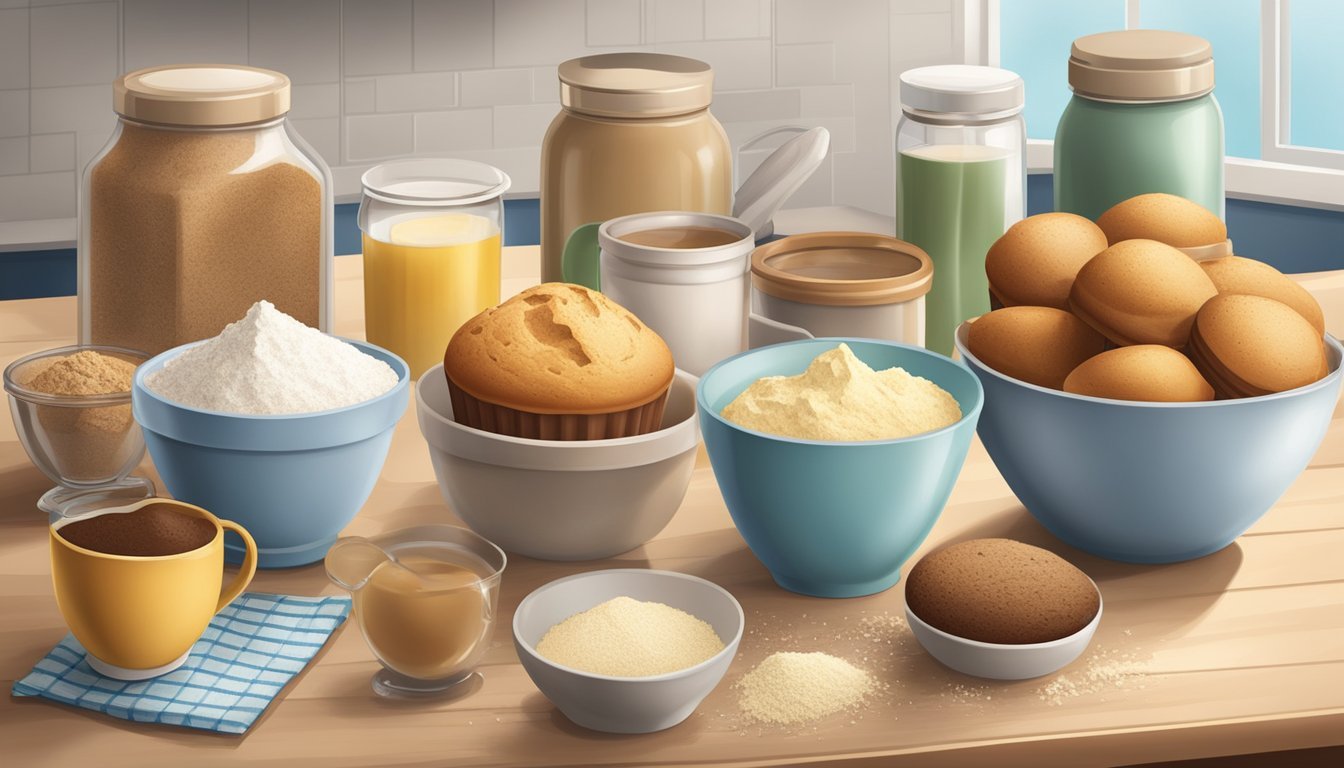Boxed Muffin Mix Loaf Cake Variations
Easy Twists on Classic Bakes
Converting a boxed muffin mix into a delicious loaf cake offers home bakers the opportunity to experiment with ease and creativity. The simplicity of starting with a premixed blend allows for a wide range of variations, creating an array of flavors and textures from a single base. These loaf cake variations delight with the dense, moist crumb of a traditional cake but emanate the comforting, familiar flavors of classic muffins. The adaptability of the mix makes it an ideal choice for those looking to personalize their baked goods without the hassle of gathering numerous ingredients.
The process begins with preheating an oven and then adjusting the muffin mix by adding ingredients typically associated with cake recipes. Eggs, oil, or melted butter, and milk are mixed into the base to enrich the batter and ensure the final product has the desired cake-like consistency. The batter is then poured into a loaf pan, an ideal shape for ensuring even baking and creating slices perfect for serving.
Modifications to the basic recipe enable the creation of various loaf cake variations. One may incorporate fruits, nuts, or chocolate chips for added texture or infuse the cake with spices, extracts, or zest for a unique flavor profile. These simple alterations transform the humble boxed mix into a customized treat, suitable for a range of occasions, from casual breakfasts to elegant desserts.
Selecting the Right Ingredients
When transforming a boxed muffin mix into a loaf cake, the ingredients used can make or break the final product. Careful selection and combination of ingredients ensures a moist, flavorful loaf cake with the desired texture and taste.
Understanding Boxed Muffin Mix
Boxed muffin mixes contain pre-measured dry ingredients, typically including flour, sugar, baking powder, and salt. Some also include flavor elements like cocoa powder for chocolate muffin mix or dried fruit in a blueberry muffin mix. Choosing a high-quality mix impacts the flavor and texture of the loaf cake.
Choosing Complementary Add-Ins
Add-ins are critical for adding texture and enhancing flavor. Here are some popular choices:
Berries: Fold in fresh or frozen berries to complement a berry muffin mix.
Nuts: Chopped nuts like walnuts or almonds add crunch and pair well with banana muffin mixes.
Chocolate Chips: Stir in chocolate chips to enrich chocolate muffin mixes.
Spices: Cinnamon or nutmeg can intensify the flavors in an apple or pumpkin muffin mix.
Dried Fruit: Mix in dried fruit like raisins or apricots to add chewiness.
Zest: Lemon or orange zest brings a fresh zing to a vanilla or poppy seed mix.
Incorporate these add-ins gently into the batter to avoid overmixing, which can lead to a dense cake.
The Role of Eggs, Milk, and Oil
Eggs, milk, and oil are essential wet ingredients that bind the batter and contribute to the cake's moistness and richness. For a standard boxed muffin mix:
Eggs: They add structure and richness. Typically, 2-3 large eggs are sufficient.
Milk: It creates a smoother batter. One can use 1 cup of milk for added moisture.
Oil: A neutral oil like vegetable or canola, usually ½ cup, is preferred for moisture without overpowering flavor.
Adjust the quantity of these ingredients slightly if the batter appears too thick or thin. Proper consistency is crucial for a loaf cake that rises well and has a tender crumb.
Preparation Techniques
Transforming boxed muffin mix into a loaf cake requires attention to batter consistency, pan preparation, and temperature control for optimal results.
Batter Consistency and Mixing
The key to a good loaf cake batter lies in achieving the right consistency. The batter should be mixed until just combined to avoid overmixing, which can lead to a dense and tough cake. It's recommended to use:
Eggs: Room temperature, for better incorporation.
Butter or Oil: Depending on the recipe, for moisture and richness.
Liquid (milk or water): As specified on the mix box or slightly reduced for a denser cake consistency.
Note: Mix until smooth and all the ingredients are well incorporated.
Greasing and Lining the Pan
Proper pan preparation is crucial to ensure the loaf cake releases easily after baking. One should:
Grease the loaf pan thoroughly with butter or non-stick cooking spray.
Line the pan with parchment paper for easier removal, leaving an overhang on the sides to lift the cake out after baking.
Preheating and Temperature Control
Accurate temperature is essential for even baking and optimal rise. Follow these steps:
Preheat the oven to the temperature suggested on the boxed mix; typically between 350-375°F (175-190°C).
Monitor the oven temperature with an oven thermometer.
Remember: Slight adjustments to the temperature may be needed depending on the oven's characteristics and the desired cake texture.
Baking Process and Adjustments
The transformation of a boxed muffin mix into a delightful loaf cake requires careful adjustments to the baking process. These tweaks ensure the correct texture and doneness.
Adapting Muffin Mix to Loaf Cake
To adapt a muffin mix for a loaf cake, one must alter the ingredient ratios slightly. A general guideline is to add three large eggs, 1/2 cup of melted butter, and 1 cup of milk to the mix to achieve a smooth batter suitable for a loaf cake's denser structure. It's essential to combine these ingredients until smooth before pouring into a greased loaf pan.
Determining Correct Baking Time
The baking time for a loaf cake made from muffin mix will differ from that of muffins due to its size and volume. As a starting point, an oven should be preheated to the temperature specified on the muffin mix box, usually 350°F to 375°F. A loaf cake generally requires 45 to 60 minutes of baking time, but this can vary based on the oven and specific mix used.
Testing for Doneness
To test for doneness, one should employ the toothpick test—a clear indicator that the loaf cake is properly baked. Insert a toothpick into the center of the cake; if it comes out clean or with a few crumbs (but no wet batter), the cake is done. If the toothpick is wet, additional baking time is needed, checking every 5 to 10 minutes to avoid overbaking.
Enhancements and Flavorings
Transforming a simple boxed muffin mix into a delicious loaf cake is easily achieved by incorporating an array of flavorings and mix-ins. Through careful selection of complementary flavors and textures, one can elevate the taste profile of the cake significantly.
Incorporating Flavor Variations
To infuse the loaf cake with diverse flavors, experiment with a variety of extracts and spices. Adding vanilla extract can impart a rich, classic sweetness to the cake. Adventurous bakers may also experiment with almond, lemon, or coconut extracts to tailor the flavor to their liking. Spices such as cinnamon or nutmeg can complement fruit-based muffin mixes and create more complex flavor profiles.
Creative Use of Frosting and Glazes
A well-chosen frosting or glaze can serve as the perfect finish to enhance the flavor and appearance of the loaf cake. A smooth cream cheese frosting pairs exceptionally well with flavors like pumpkin or banana. Besides the traditional buttercream, one can opt for glazes that range from simple powdered sugar and milk to more elaborate lemon or chocolate glazes.
Additional Mix-Ins for Texture
Adding various mix-ins not only contributes to the overall flavor but also introduces intriguing textures. Consider folding in chocolate chips, fruits like blueberries or diced apples, or even nuts for a satisfying crunch. The key is to gently fold these ingredients into the batter to ensure even distribution and to maintain the integrity of the mix-ins during baking.
Serving and Presentation
When presenting a boxed muffin mix loaf cake, the focus is on the visual appeal and the ease with which it can be served. The right techniques and garnishes can transform this simple home-baked good into a centerpiece-worthy dessert.
Slicing and Serving Techniques
For even slices, a serrated knife ensures clean cuts without crumbling the cake. Begin by trimming off the uneven top to create a flat surface, which also offers a professional look. Serve each slice on individual plates or arrange them on a serving platter cascading for visual impact.
Decorative Toppings
To elevate the appearance, a dusting of powdered sugar or a drizzle of icing can add both sweetness and a touch of elegance. Consider the event and season when selecting your toppings:
For a citrus twist: Add grated lemon or orange zest atop the loaf.
Almond Slices: Pressing sliced almonds into the top before baking adds a crunchy texture.
Pairing with Beverages and Ice Cream
Pair the loaf cake with beverages to complement its flavor and richness. A strong hot coffee cuts through the sweetness, while a glass of cold milk is a classic accompaniment. For dessert serving, a scoop of vanilla or almond ice cream on the side balances the cake's aroma and enhances the experience.
Storing and Repurposing Leftovers
When dealing with leftovers of a boxed muffin mix loaf cake, the focus should be on maintaining the cake's moisture and freshness, while also being creative in repurposing any excess cake into new, delightful treats.
Keeping the Cake Moist and Fresh
To keep the leftover cake moist and fresh, one should store it in an airtight container. For short-term storage:
Wrap slices or the entire cake in plastic wrap or aluminum foil.
Place the wrapped cake in an airtight container.
Store it in the refrigerator to extend freshness.
For the long-term option:
Ensure that the cake is free from any icing or glaze to avoid stickiness.
Wrap each slice tightly in plastic wrap, followed by foil.
Freeze, allowing the cake to maintain its texture for later consumption.
Innovative Ideas for Leftover Cake
Leftover cake presents an opportunity for culinary creativity. Instead of discarding stale pieces, they can be transformed into new confections:
Cupcake Trifle: Layer crumbled cake with whipped cream and fresh berries in a glass to make a quick trifle.
Cake Pudding: Cube the leftover cake and mix it with a custard base. Bake until set for a delicious bread pudding spin-off.
Sweet Crumbs: Process the leftover cake into fine crumbs and use as a topping for ice cream or mix into cookie batter for an added sweet kick.
Advanced Tips and Common Pitfalls
When transforming boxed muffin mix into a loaf cake, bakers often face challenges such as adjusting for altitude and humidity, avoiding baking mistakes, and utilizing baking equipment effectively. Understanding these nuances can significantly improve the quality of the final product.
Adjusting for Altitude and Humidity
At high altitudes, bakers should increase the amount of baking powder slightly to ensure proper rise. For every 1,000 feet above sea level, one can add 1/4 teaspoon of baking powder to the mix. Humidity can affect the dryness of ingredients; in humid conditions, it may be necessary to reduce the amount of wet ingredients to combat stickiness.
High Altitude: Add +1/4 tsp baking powder per 1,000 feet
High Humidity: Reduce wet ingredients such as water or buttermilk
Avoiding Common Baking Mistakes
To prevent a loaf cake from becoming dense or tough, one should not overmix the batter. Using a whisk or spatula, gently fold wet ingredients into dry until just combined. Check the freshness of the baking soda and baking powder before starting, as stale leaveners can lead to a flat, unappealing cake.
Mixing: Fold gently until just combined
Leaveners: Ensure baking soda and powder are fresh
Utilizing Baking Equipment Effectively
Use the correct size loaf pan to ensure even baking. Bakers should preheat the oven to the temperature recommended for a cake, generally around 350°F, as boxed mixes often list temperatures suited for muffins. Grease the pan thoroughly to avoid sticking, or line it with parchment paper for easy removal.
Loaf Pan: Correct size for even baking
Baking Temperature: Preheat to 350°F for cakes
Greasing: Prevent sticking with a thorough coating or parchment paper









